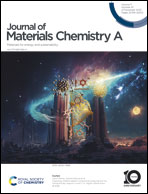High piezoelectricity induced by lattice distortion and domain realignment in Li2CO3-added lead-based ceramics†
Abstract
The 0.2Pb(Ni1/3Nb2/3)O3–0.1Pb(Zn1/3Nb2/3)O3–0.7Pb(Zr0.46Ti0.54)O3 + xwt% Li2CO3 ceramics were synthesized by the solid-state reaction method. After doping Li+ ions into the ceramics, the [BO6] oxygen octahedra stretch along the direction of the spontaneous polarization (Ps), which increases the Ps and improves the internal contribution to the piezoelectric properties. The calculated Ps and measured Ps have the same trend with increasing the Li2CO3 content from 0.0 to 0.6 wt%, confirming that the Rietveld refinement results are reliable. The local structural distortion is observed by scanning transmission electron microscopy (STEM). Meanwhile, the increased relaxation promotes the formation of short-ordered nanoscale domains, making the domain rotation and the domain-wall motion easier, thus improving the external contribution to the piezoelectric properties. The ratio of extrinsic contribution increases as the electric field increases. The nanoscale domains have lower activation energy of domain wall (Ea) movement than the micron-scale domains.

- This article is part of the themed collection: 2023 Journal of Materials Chemistry A HOT Papers


 Please wait while we load your content...
Please wait while we load your content...